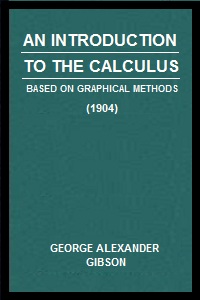An Introduction to the Calculus Based on Graphical Methods by George Gibson - PDF

About this book :-
"An Introduction to the Calculus Based on Graphical Methods" by "George Gibson" is a classic textbook designed to teach the fundamentals of "calculus" through visual and intuitive approaches. Unlike traditional algebra-heavy texts, Gibson emphasizes understanding "differentiation" and "integration" by showing how functions behave graphically. This makes complex concepts more approachable for beginners and students who benefit from seeing mathematical ideas in action rather than relying solely on formulas.
The book covers essential topics such as slopes, rates of change, and areas under curves, illustrating how derivatives and integrals describe real-world phenomena. Each concept is paired with clear graphs and step-by-step explanations, helping learners connect visual intuition with formal mathematical reasoning. Gibson’s method allows students to see the relationship between the shape of a curve and its corresponding derivative or integral, fostering a deeper understanding of "graphical methods" in calculus.
By combining clarity, practicality, and visual learning, "An Introduction to the Calculus Based on Graphical Methods" remains a valuable resource for grasping the core principles of "calculus", offering both intuition and technical understanding for learners in mathematics, physics, and engineering.
Book Detail :-
Title:
An Introduction to the Calculus Based on Graphical Methods by George Gibson - PDF
Publisher:
MacMillan London
Year:
1904
Pages:
252
Type:
PDF
Language:
English
ISBN-10 #:
1110138121
ISBN-13 #:
978-1110138128
License:
Public Domain Work
Amazon:
Amazon
About Author :-
The author
George Alexander Gibson
was a mathematician and educator known for making "calculus" accessible through "graphical methods". He focused on helping students understand complex ideas like "differentiation" and integration by visualizing functions rather than relying only on formulas. He authored "An Introduction to the Calculus Based on Graphical Methods" to teach beginners the fundamentals of "calculus" in a clear, intuitive way. Gibson’s approach connects theory with visual intuition, helping learners grasp slopes, rates of change, and areas under curves, making calculus easier to understand and apply in mathematics, physics, and engineering.
Book Contents :-
1. Introduction
2. Differentiation Of Powers. Maxima And Minima
3. Differentials. Higher Derivatives
4. Applications To Mechanics. Further Theorems On Differentiation
5. Integration Of Powers
6. Areas. Definite Integrals
7. Integral As Limit Of A Sum. Simpson's Rules
8. Applications To Mechanics
9. Differentiation Of Direct Trigonometric Functions
10. Integration Of Direct Trigonometric
11. Fourier Series
12. Inverse Circular Functions. Logarithmic
13. Applications. Curvature. Bending Of Beams. Catenary. Alternate Currents
14. Graphical Integration
Similar
Calculus
Books